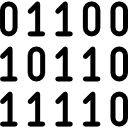Logic diagram: Difference between revisions
Mr. MacKenty (talk | contribs) |
Mr. MacKenty (talk | contribs) No edit summary |
||
| (5 intermediate revisions by the same user not shown) | |||
| Line 1: | Line 1: | ||
[[File:binary.png|frame|right|This is a basic concept in computer science]] | [[File:binary.png|frame|right|This is a basic concept in computer science]] | ||
| Line 14: | Line 8: | ||
<html> | <html> | ||
<iframe width="560" height="315" src="https://www.youtube.com/embed/VBDoT8o4q00" frameborder="0" allowfullscreen></iframe> | <iframe width="560" height="315" src="https://www.youtube.com/embed/VBDoT8o4q00" frameborder="0" allowfullscreen></iframe> | ||
</html> | </html> | ||
== Do you understand this topic? == | == Do you understand this topic? == | ||
This can be tricky. There is a neat [ | This can be tricky. There is a neat [https://academo.org/demos/logic-gate-simulator/ interactive web-based application here] that is helpful for understanding logic diagrams | ||
# Construct a logic diagram using AND | # Construct a logic diagram using AND | ||
| Line 30: | Line 20: | ||
# Construct a logic diagram using NOR | # Construct a logic diagram using NOR | ||
# Construct a logic diagram using XOR | # Construct a logic diagram using XOR | ||
== References == | == References == | ||
Latest revision as of 08:21, 8 April 2019
A truth table is a mathematical table used in logic—specifically in connection with Boolean algebra, boolean functions, and propositional calculus—to compute the functional values of logical expressions on each of their functional arguments, that is, on each combination of values taken by their logical variables (Enderton, 2001). In particular, truth tables can be used to tell whether a propositional expression is true for all legitimate input values, that is, logically valid.[1]
Logic Diagrams[edit]
Do you understand this topic?[edit]
This can be tricky. There is a neat interactive web-based application here that is helpful for understanding logic diagrams
- Construct a logic diagram using AND
- Construct a logic diagram using OR
- Construct a logic diagram using NOT
- Construct a logic diagram using NAND
- Construct a logic diagram using NOR
- Construct a logic diagram using XOR
